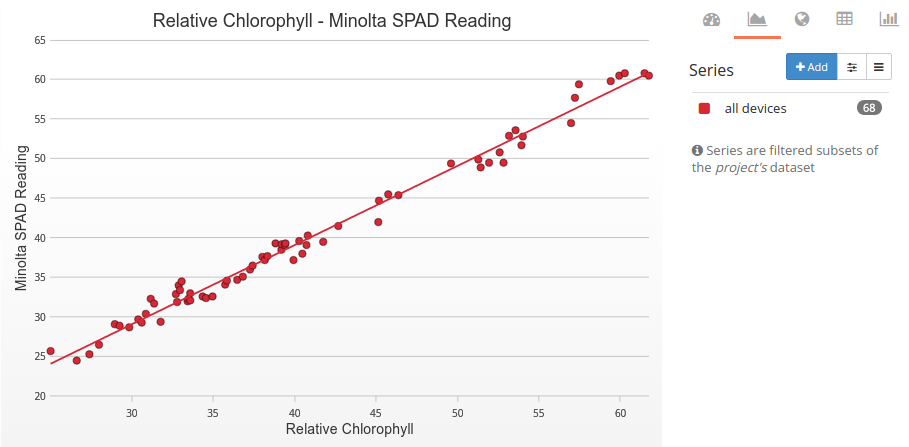Relative Chlorophyll Content Validation
The goal of this project is to validate the relative chlorophyll content measurement using the MultispeQ v1.0 device. This validation is made against an industry standard Minolta SPAD 502+. The MultispeQs used were the first 20 manufactured by Lectronics in Saline MI to be used for testing and validation.
Summary
- The MultispeQ relative chlorophyll correlates well to the industry standard Minolta SPAD 502+ (Minolta = MultispeQ * 1 - .93, r2 = .987, using 11 devices and 68 total measurements).
- Validation was performed on Ficus, Basil, Banana Tree of varying thickness (.07 - .62mm) and greenness levels (Minolta SPAD values from (24.5 - 60.8).
- Very thick (aloe) or very small leaves may require adjustments to measure consistently, but the measurement range is similar to the Minolta SPAD 502+.
Background
Relative Chlorophyll is widely used as one measure of plant health. In the simplest terms, relative chlorophyll measures the greenness of the leaf. NDVI (a reflectance-based relatively chlorophyll measure) is used in drones and planes to identify low productivity spots in fields. SPAD (an absorbance-based relative chlorophyll measure) is similar, but more accurate and requires less in-field calibration. The Minolta SPAD meter 502+ has become the standard commercially available instrument for measuring SPAD (see image below).
 Minolta 502+ SPAD meter
Minolta 502+ SPAD meter
The MultispeQ v1.0 works the same as the Minolta 502+. Transmittance is measured at 650nm (red) and 940nm (NIR) through the sample, then run the following calculation:
SPAD = 100*log(transmittance@940/transmittance@650)
The 940nm transmittance accounts (roughly) for leaf thickness. Otherwise thick, light green leaves would appear as green as thin, dark green leaves.
One problem with this measurement is that thick samples can eliminate all of the light, causing the detector to read 0 (or very close). However, if you increase the light intensity, then very thin samples can cause the detector response to be maxed out.
The MultispeQ addresses this problem by measuring Relative Chlorophyll at 3 intensities (low, medium, and high), and choosing the intensity for which the signals are not zero, and are not maxed out. This effectively acts as an auto-gain function. As a result, the thickness and greenness range of the MultispeQ is equivalent to that of the Minolta SPAD 502+ based on several tested leaves (results not shown).
Results
11 devices were calibrated it the project 4a - v1.0 FACTORY CALIBRATION. A piece of paper containing 9 squares of varying greenness and thickness, with known Minolta SPAD values, were used to calibrate the device. Those Minolta SPAD values were: 8, 17.4, 31.2, 24.4, 38.8, 47.7, 25.8, 48.6, 72 .
To validate this calibration, the devices were then taken to a greenhouse, along with a Minolta SPAD 502+ meter, and a set of 68 leaves were measured varying in thickness and greenness. For each leaf, an average of 5 Minolta SPAD values were taken and a single MultispeQ SPAD value was taken. The reason to average 5 Minolta SPAD values is the Minolta SPAD measurement area is very small (about 2.5mm x 2.5mm), while the MultispeQ measurement area is 9mm x 9mm. As a result, several Minolta readings throughout a 9mm x 9mm are needed to provide a comparable data point to a single MultispeQ reading. The graph comparing the two is shown below.

A linear fit between Minolta SPAD and MultispeQ SPAD was created. The ideal equation for the fit is minolta.SPAD = 1 x multispeq.SPAD + 0 (ie Minolta SPAD equals MultispeQ SPAD).
y = 1x + -0.93 (r2 0.987)
This fit is very close to the ideal. However, there can be variation from device to device. The below graph shows each devices comparison against the Minolta.

The fits for each separate device are shown below:

Device 0C is a significant outlier with a coefficient of .76, otherwise the remaining devices were 10% of the ideal slope and 4 of the ideal y-intercept.
Other sources of error
As mentioned above, there is a maximum thickness for which this measurement will work - very thick leaves (aloe plants, for example) can produce either no result, or a biased result. The Minolta 502+ has similar issues on thick leaves.
Another source of error in the field applies to very small leaves. The measurement area of the MultispeQ is 9mm x 9mm, which is sometimes larger than the leaf being measured. It's important to be careful to fully cover the measurement area, otherwise results will be incorrect. If leaves are too small to be covered, it's possible to mask the device (decrease the measurement area to the size of the leaf) and recalibrate the SPAD values with mask in place.